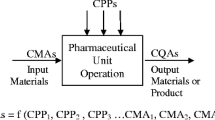Abstract
In the present times, due to increase in customer demands, products complexity is on the rise. This calls for the designers to strike a balance between a wide range of design alternatives and a large set of conflicting criteria. Hence, to take a sound decision by identifying a viable combination of customer requirements and satisfy the conflicting requirements is a difficult task for both the designer and the manufacturer. This work extends the axiomatic design theory to align the customer requirements (CRs) and design parameters (DPs) and generates multiple possible design alternatives based on the weightages of analytic hierarchy process (AHP). Such design alternatives are evaluated on the basis of their overall performance in line with the expected customer attributes, and the best design is identified by integrating the technique for order of preference by similarity to ideal solution, a ranking multi-criteria decision-making method, with AHP. This work unfolds a support tool for decision makers to accurately and effectively select CRs by a useful aggregation of function requirements and DPs. An industrial example is produced to demonstrate the applicability of the proposed method. This intelligent decision-making method is useful from the customers as well as the manufacturers’ perspective.


Similar content being viewed by others
References
Albayrak, E., & Erensal, Y. C. (2004). Using analytic hierarchy process (AHP) to improve human performance: An application of multiple criteria decision making problem. Journal of Intelligent Manufacturing, 15(4), 491–503.
Behzadian, M., Otaghsara, S. K., Yazdani, M., & Ignatius, J. (2012). A state-of the-art survey of TOPSIS applications. Expert Systems with Applications, 39(17), 13051–13069.
Bhutia, P. W., & Phipon, R. (2012). Application of ahp and topsis method for supplier selection problem. IOSR Journal of Engineering (IOSRJEN), 2, 43–50.
Cui, A. S., & Wu, F. (2015). Utilizing customer knowledge in innovation: Antecedents and impact of customer involvement on new product performance. Journal of the Academy of Marketing Science, 44, 1–23.
Dağdeviren, M. (2008). Decision making in equipment selection: An integrated approach with AHP and PROMETHEE. Journal of Intelligent Manufacturing, 19(4), 397–406.
Do, S. H., & Park, G. J. (2001). Application of design axioms for glass bulb design and software development for design automation. Journal of Mechanical Design, 123(3), 322–329.
Gu, P., Rao, H. A., & Tseng, M. M. (2001). Systematic design of manufacturing systems based on axiomatic design approach. CIRP Annals-Manufacturing Technology, 50(1), 299–304.
Guan, X., Wang, Y., & Tao, L. (2009). Machining scheme selection of digital manufacturing based on genetic algorithm and AHP. Journal of Intelligent Manufacturing, 20(6), 661–669.
Han, W. J., & Tsay, W. D. (1998). Formulation of quality strategy using analytic hierarchy process. In Twenty seven annual meeting of the western decision science institute, University of Northern Colorado, USA, pp. 580–583.
Harding, J. A., Popplewell, K., Fung, R. Y., & Omar, A. R. (2001). An intelligent information framework relating customer requirements and product characteristics. Computers in Industry, 44(1), 51–65.
Hirani, H., & Suh, N. P. (2005). Journal bearing design using multiobjective genetic algorithm and axiomatic design approaches. Tribology International, 38(5), 481–491.
Hua Lu, M., Madu, C. N., Kuei, C. H., & Winokur, D. (1994). Integrating QFD, AHP and benchmarking in strategic marketing. Journal of Business and Industrial Marketing, 9(1), 41–50.
Hwang, C. L., & Yoon, K. (1981). Methods for multiple attribute decision making. In Multiple attribute decision making (Vol. 186, pp. 58–191). Springer, Berlin.
Junior, F. R. L., Osiro, L., & Carpinetti, L. C. R. (2014). A comparison between fuzzy AHP and fuzzy TOPSIS methods to supplier selection. Applied Soft Computing, 21, 194–209.
Kim, G., Park, C. S., & Yoon, K. P. (1997). Identifying investment opportunities for advanced manufacturing systems with comparative-integrated performance measurement. International Journal of Production Economics, 50(1), 23–33.
Kremer, G. O., Chiu, M. C., Lin, C. Y., Gupta, S., Claudio, D., & Thevenot, H. (2012). Application of axiomatic design, TRIZ, and mixed integer programming to develop innovative designs: A locomotive ballast arrangement case study. The International Journal of Advanced Manufacturing Technology, 61(5–8), 827–842.
Krishnapillai, R., & Zeid, A. (2006). Mapping product design specification for mass customization. Journal of Intelligent Manufacturing, 17(1), 29–43.
Kumar, A., Jain, V., & Kumar, S. (2014). A comprehensive environment friendly approach for supplier selection. Omega, 42(1), 109–123.
Kusiak, A. (1999). Engineering design: Products, processes, and systems. San Diego, CA: Academic Press.
Lin, M. C., Wang, C. C., Chen, M. S., & Chang, C. A. (2008). Using AHP and TOPSIS approaches in customer-driven product design process. Computers in Industry, 59(1), 17–31.
Park, K., Kang, B., Song, K., & Park, G. (2003). Design of a spacer grid using axiomatic design. Journal of Nuclear Science and Technology, 40(12), 989–997.
Saaty, L. (1980). The analytic hierarchy process. New York: McGraw-Hill.
Saaty, T. L. (1990). How to make a decision: The analytic hierarchy process. European Journal of Operational Research, 48(1), 9–26.
Sharma, S., & Balan, S. (2013). An integrative supplier selection model using Taguchi loss function, TOPSIS and multi criteria goal programming. Journal of Intelligent Manufacturing, 24(6), 1123–1130.
Shih, H. S., Shyur, H. J., & Lee, E. S. (2007). An extension of TOPSIS for group decision making. Mathematical and Computer Modelling, 45(7), 801–813.
Shirwaiker, R. A., & Okudan, G. E. (2008). Triz and axiomatic design: A review of case-studies and a proposed synergistic use. Journal of Intelligent Manufacturing, 19(1), 33–47.
Suh, N. P. (1990). The principles of design (Vol. 990). New York: Oxford University Press.
Suh, N. P. (2005). Complexity: Theory and applications. New York: Oxford University Press on Demand.
Wang, X., Chan, H. K., Lee, C. K., & Li, D. (2015). A hierarchical model for eco-design of consumer electronic products. Technological and Economic Development of Economy, 21(1), 48–64.
Yang, K., & Zhang, H. (2000). Compatibility analysis and case studies of axiomatic design and TRIZ. The TRIZ Journal. http://www.triz-journal.com.
Author information
Authors and Affiliations
Corresponding author
Rights and permissions
About this article
Cite this article
Kumar, P., Tandon, P. A paradigm for customer-driven product design approach using extended axiomatic design. J Intell Manuf 30, 589–603 (2019). https://doi.org/10.1007/s10845-016-1266-2
Received:
Accepted:
Published:
Issue Date:
DOI: https://doi.org/10.1007/s10845-016-1266-2




